A Report on How to Establish a Stimulating Learning Environment
VerifiedAdded on 2023/06/16
|10
|2351
|229
Report
AI Summary
This assignment delves into establishing a stimulating learning environment for children, exploring both indoor and outdoor play scenarios. It references the Early Years Learning Framework (EYLF), emphasizing belonging, being, and becoming, and the importance of secure, respectful relationships, partnership with parents, respect for diversity, and high expectations. The report discusses holistic approaches, responsiveness to children, learning through play, and intentional teaching. It analyzes a transcript of a child's responses to questions about their preferences and interests, highlighting the child's knowledge of colors, preference for outdoor play, and connection with family and friends. The assignment also covers strategies for supporting child development, including problem-solving, building prior knowledge, and using visual aids. It further addresses the role of educators in understanding children's feelings, allowing them to learn through experience, and providing additional support with knowledge, skills, and resources. Scaffolding and routine times are discussed as methods for enhancing learning, and the importance of outdoor experiences for mental health is emphasized. The assignment concludes with a reflection on the student's own words and knowledge, with appropriate references provided; Desklib offers similar solved assignments and resources for students.
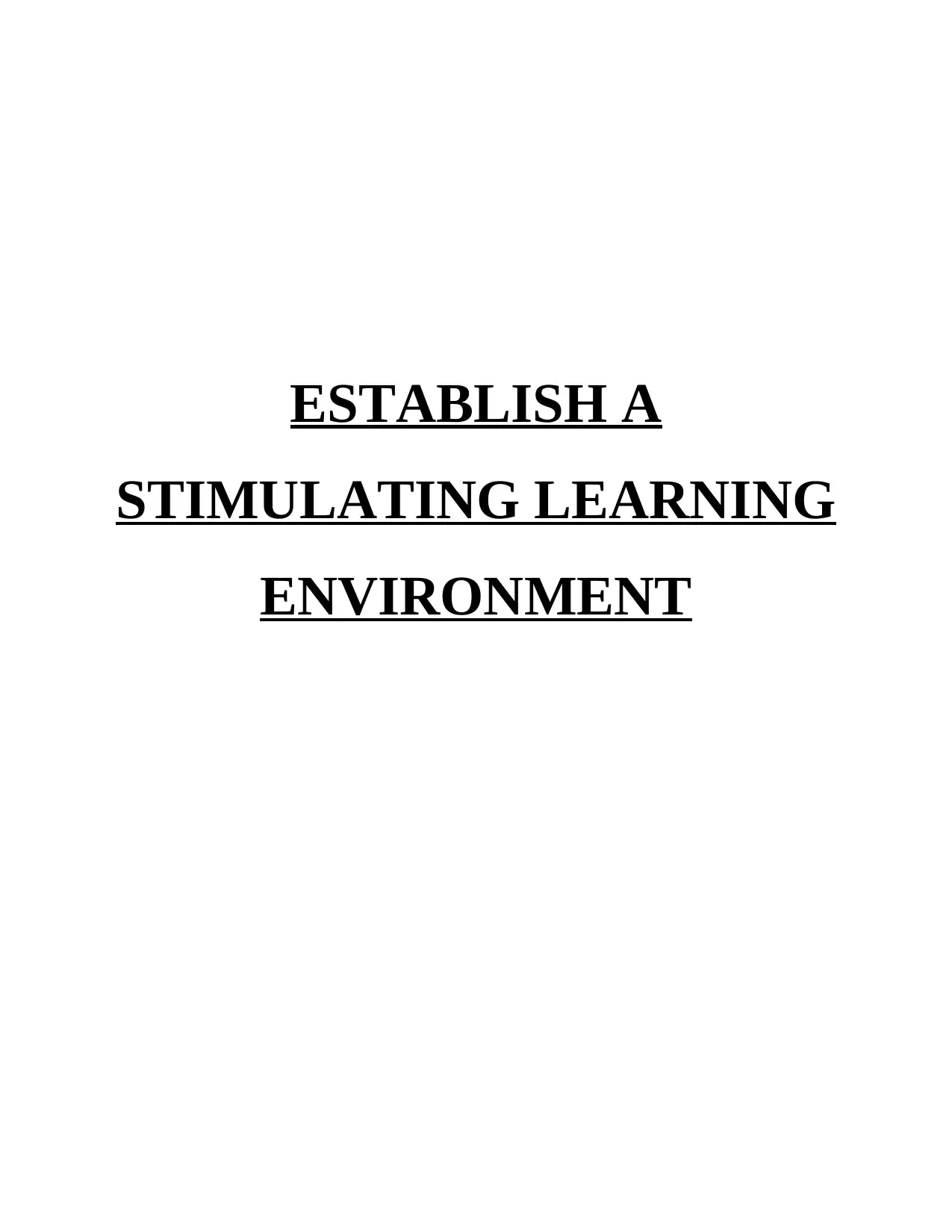
ESTABLISH A
STIMULATING LEARNING
ENVIRONMENT
STIMULATING LEARNING
ENVIRONMENT
Paraphrase This Document
Need a fresh take? Get an instant paraphrase of this document with our AI Paraphraser
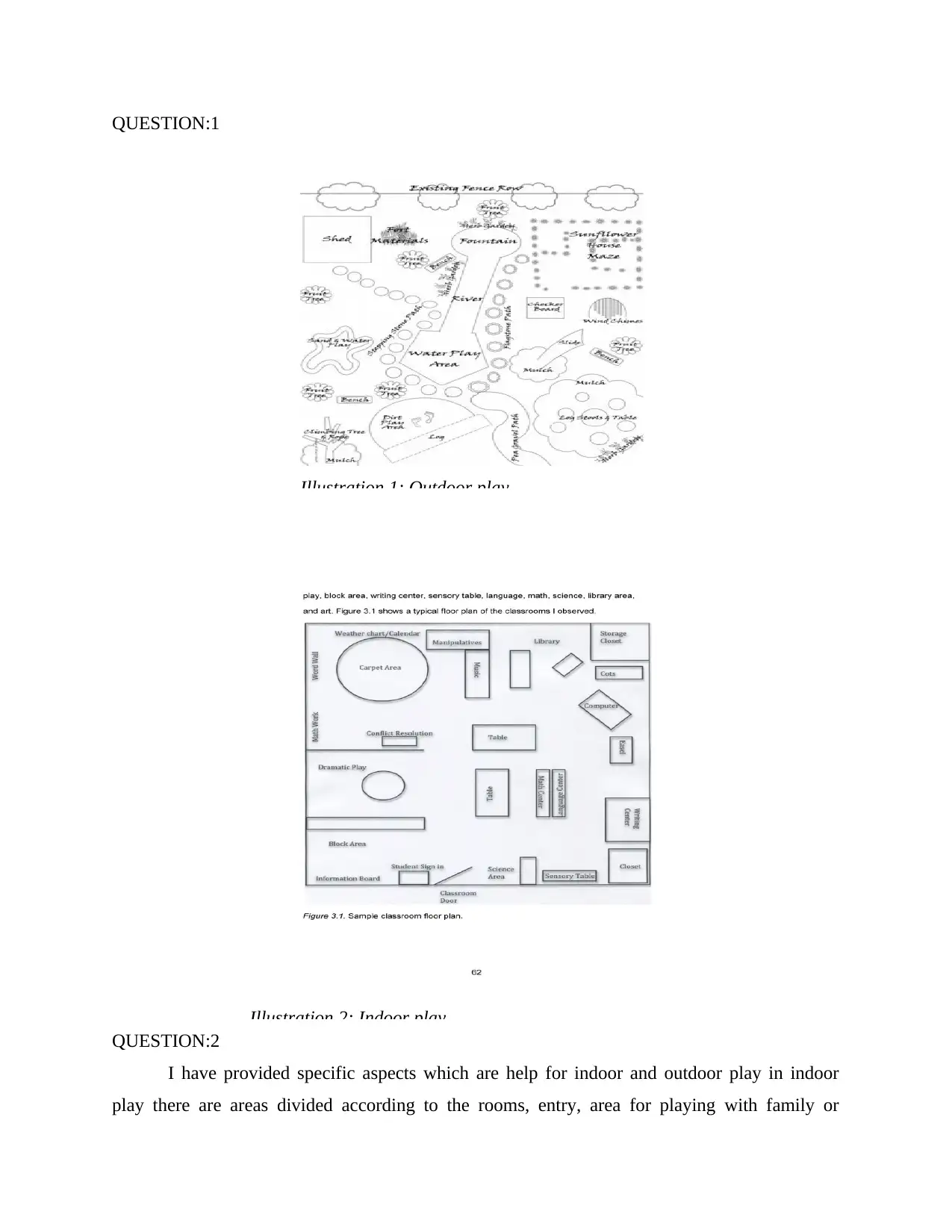
QUESTION:1
QUESTION:2
I have provided specific aspects which are help for indoor and outdoor play in indoor
play there are areas divided according to the rooms, entry, area for playing with family or
Illustration 1: Outdoor play
Illustration 2: Indoor play
QUESTION:2
I have provided specific aspects which are help for indoor and outdoor play in indoor
play there are areas divided according to the rooms, entry, area for playing with family or
Illustration 1: Outdoor play
Illustration 2: Indoor play
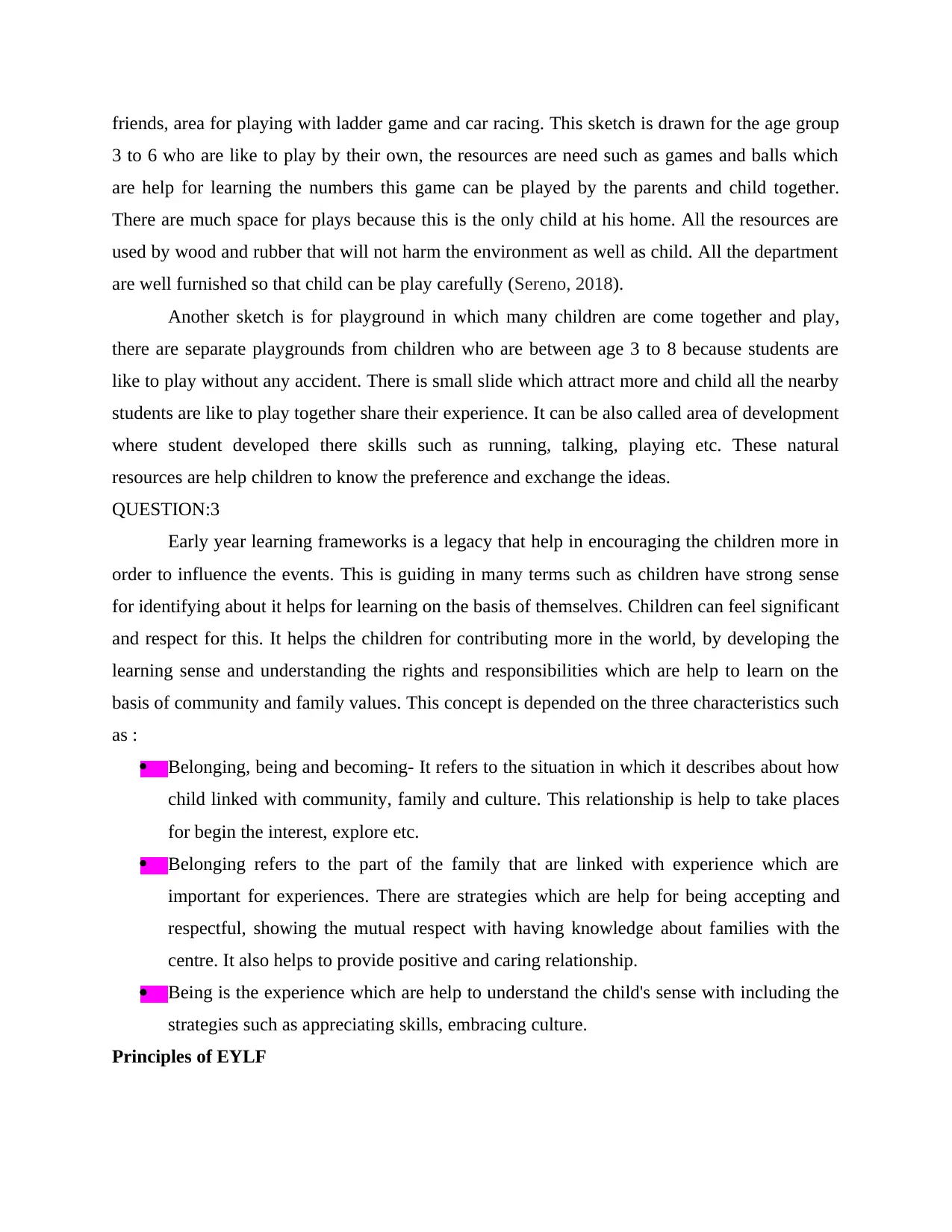
friends, area for playing with ladder game and car racing. This sketch is drawn for the age group
3 to 6 who are like to play by their own, the resources are need such as games and balls which
are help for learning the numbers this game can be played by the parents and child together.
There are much space for plays because this is the only child at his home. All the resources are
used by wood and rubber that will not harm the environment as well as child. All the department
are well furnished so that child can be play carefully (Sereno, 2018).
Another sketch is for playground in which many children are come together and play,
there are separate playgrounds from children who are between age 3 to 8 because students are
like to play without any accident. There is small slide which attract more and child all the nearby
students are like to play together share their experience. It can be also called area of development
where student developed there skills such as running, talking, playing etc. These natural
resources are help children to know the preference and exchange the ideas.
QUESTION:3
Early year learning frameworks is a legacy that help in encouraging the children more in
order to influence the events. This is guiding in many terms such as children have strong sense
for identifying about it helps for learning on the basis of themselves. Children can feel significant
and respect for this. It helps the children for contributing more in the world, by developing the
learning sense and understanding the rights and responsibilities which are help to learn on the
basis of community and family values. This concept is depended on the three characteristics such
as :
Belonging, being and becoming- It refers to the situation in which it describes about how
child linked with community, family and culture. This relationship is help to take places
for begin the interest, explore etc.
Belonging refers to the part of the family that are linked with experience which are
important for experiences. There are strategies which are help for being accepting and
respectful, showing the mutual respect with having knowledge about families with the
centre. It also helps to provide positive and caring relationship.
Being is the experience which are help to understand the child's sense with including the
strategies such as appreciating skills, embracing culture.
Principles of EYLF
3 to 6 who are like to play by their own, the resources are need such as games and balls which
are help for learning the numbers this game can be played by the parents and child together.
There are much space for plays because this is the only child at his home. All the resources are
used by wood and rubber that will not harm the environment as well as child. All the department
are well furnished so that child can be play carefully (Sereno, 2018).
Another sketch is for playground in which many children are come together and play,
there are separate playgrounds from children who are between age 3 to 8 because students are
like to play without any accident. There is small slide which attract more and child all the nearby
students are like to play together share their experience. It can be also called area of development
where student developed there skills such as running, talking, playing etc. These natural
resources are help children to know the preference and exchange the ideas.
QUESTION:3
Early year learning frameworks is a legacy that help in encouraging the children more in
order to influence the events. This is guiding in many terms such as children have strong sense
for identifying about it helps for learning on the basis of themselves. Children can feel significant
and respect for this. It helps the children for contributing more in the world, by developing the
learning sense and understanding the rights and responsibilities which are help to learn on the
basis of community and family values. This concept is depended on the three characteristics such
as :
Belonging, being and becoming- It refers to the situation in which it describes about how
child linked with community, family and culture. This relationship is help to take places
for begin the interest, explore etc.
Belonging refers to the part of the family that are linked with experience which are
important for experiences. There are strategies which are help for being accepting and
respectful, showing the mutual respect with having knowledge about families with the
centre. It also helps to provide positive and caring relationship.
Being is the experience which are help to understand the child's sense with including the
strategies such as appreciating skills, embracing culture.
Principles of EYLF
⊘ This is a preview!⊘
Do you want full access?
Subscribe today to unlock all pages.

Trusted by 1+ million students worldwide

Secure, respectful and reciprocal relationship- Children thought and feeling are more
aware about the positively interacting on the basis of each other. It develops the child's sense of
well-being, this will help when he grows and the knowledge is having by him is very helpful.
Also, there are different types of exercise which are help the student in order to gain knowledge
by him.
Partnership- This is very necessary to working with parents from the early childhood
setting, it creates welcome and warm environment for families as well as children. Children are
learned new things and it creates healthy environment so that child is learned new things.
Respect for diversity- Respect elders is reflecting the values and beliefs, It shows,
language, traditions, history etc. It promotes greater understanding for children from the
childhood. It is very important to taught right language to children in order to get idea about it.
Language shows the area of knowledge of the person (Khandelwal, 2019).
High expectation and equity- It believes that there are children who are able to succeed
and regards to abilities and cultural diversities. Also, parents has high expectation for the
achievement in learning. It is ensured about the child has the opportunities that are need to
achieve in the learning outcomes.
Practices of EYLF
Holistic approaches- It is the approach which is recognition of mind, spirit and body. For
the aspect of learning it is important to know about personal, physical, emotional and social
cognitive and spiritual well-being. It enhances the children understanding for the natural
environment with connection of plants, people, animals and land.
Responsiveness to children- This is help for being aware for responding strength, abilities
and interest the value and children strength are extended of learning also skills, knowledge,
interest etc. There are different interest of the person and it needs developments in order to
extend the learning by experience.
Learning through play- There are providing amounts of opportunities for the children for
discover, explore, imagine and create. To play with children help to expand the thinking and also
promotes the approach of learning. For creating the learning environment is encourages the
children for building on children's learning in positive ways.
aware about the positively interacting on the basis of each other. It develops the child's sense of
well-being, this will help when he grows and the knowledge is having by him is very helpful.
Also, there are different types of exercise which are help the student in order to gain knowledge
by him.
Partnership- This is very necessary to working with parents from the early childhood
setting, it creates welcome and warm environment for families as well as children. Children are
learned new things and it creates healthy environment so that child is learned new things.
Respect for diversity- Respect elders is reflecting the values and beliefs, It shows,
language, traditions, history etc. It promotes greater understanding for children from the
childhood. It is very important to taught right language to children in order to get idea about it.
Language shows the area of knowledge of the person (Khandelwal, 2019).
High expectation and equity- It believes that there are children who are able to succeed
and regards to abilities and cultural diversities. Also, parents has high expectation for the
achievement in learning. It is ensured about the child has the opportunities that are need to
achieve in the learning outcomes.
Practices of EYLF
Holistic approaches- It is the approach which is recognition of mind, spirit and body. For
the aspect of learning it is important to know about personal, physical, emotional and social
cognitive and spiritual well-being. It enhances the children understanding for the natural
environment with connection of plants, people, animals and land.
Responsiveness to children- This is help for being aware for responding strength, abilities
and interest the value and children strength are extended of learning also skills, knowledge,
interest etc. There are different interest of the person and it needs developments in order to
extend the learning by experience.
Learning through play- There are providing amounts of opportunities for the children for
discover, explore, imagine and create. To play with children help to expand the thinking and also
promotes the approach of learning. For creating the learning environment is encourages the
children for building on children's learning in positive ways.
Paraphrase This Document
Need a fresh take? Get an instant paraphrase of this document with our AI Paraphraser
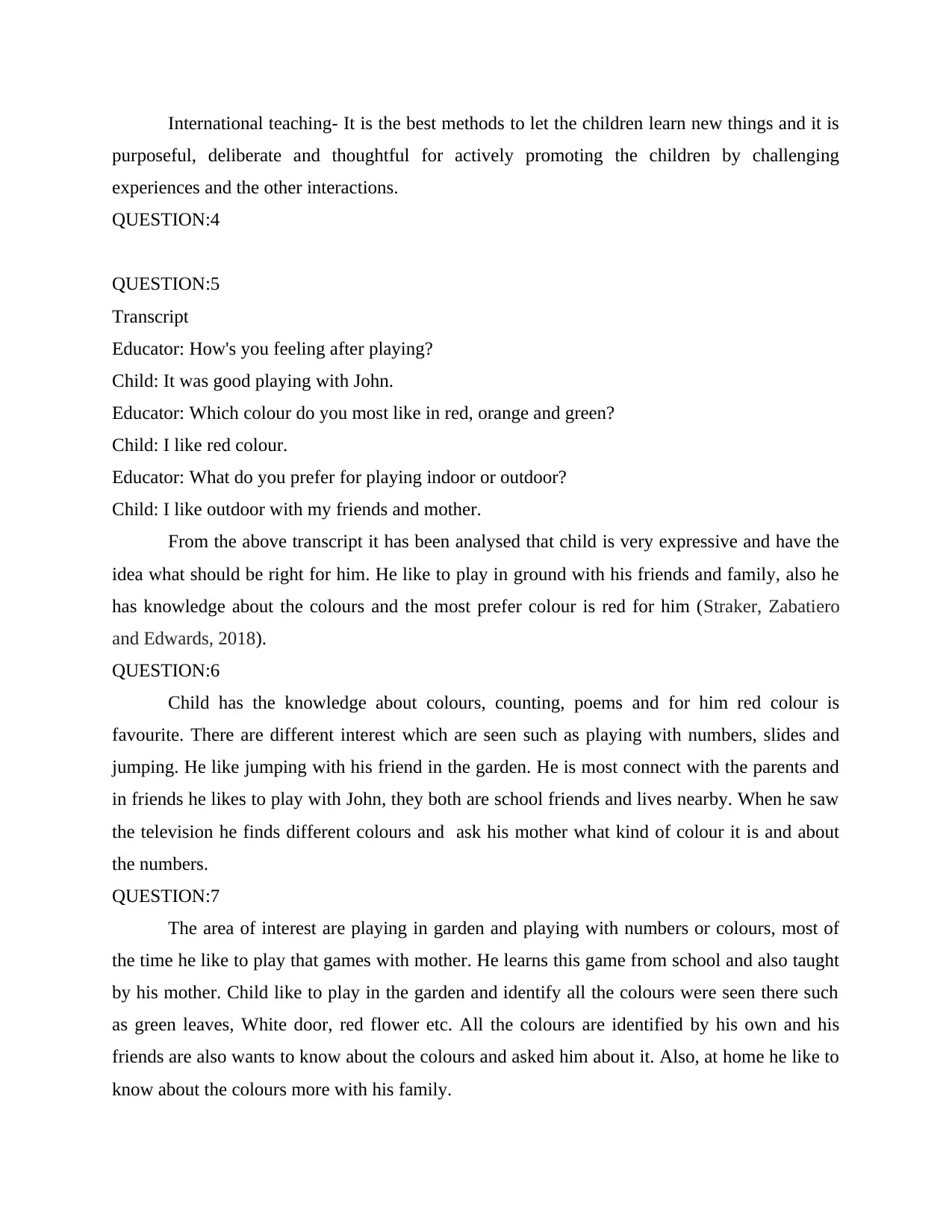
International teaching- It is the best methods to let the children learn new things and it is
purposeful, deliberate and thoughtful for actively promoting the children by challenging
experiences and the other interactions.
QUESTION:4
QUESTION:5
Transcript
Educator: How's you feeling after playing?
Child: It was good playing with John.
Educator: Which colour do you most like in red, orange and green?
Child: I like red colour.
Educator: What do you prefer for playing indoor or outdoor?
Child: I like outdoor with my friends and mother.
From the above transcript it has been analysed that child is very expressive and have the
idea what should be right for him. He like to play in ground with his friends and family, also he
has knowledge about the colours and the most prefer colour is red for him (Straker, Zabatiero
and Edwards, 2018).
QUESTION:6
Child has the knowledge about colours, counting, poems and for him red colour is
favourite. There are different interest which are seen such as playing with numbers, slides and
jumping. He like jumping with his friend in the garden. He is most connect with the parents and
in friends he likes to play with John, they both are school friends and lives nearby. When he saw
the television he finds different colours and ask his mother what kind of colour it is and about
the numbers.
QUESTION:7
The area of interest are playing in garden and playing with numbers or colours, most of
the time he like to play that games with mother. He learns this game from school and also taught
by his mother. Child like to play in the garden and identify all the colours were seen there such
as green leaves, White door, red flower etc. All the colours are identified by his own and his
friends are also wants to know about the colours and asked him about it. Also, at home he like to
know about the colours more with his family.
purposeful, deliberate and thoughtful for actively promoting the children by challenging
experiences and the other interactions.
QUESTION:4
QUESTION:5
Transcript
Educator: How's you feeling after playing?
Child: It was good playing with John.
Educator: Which colour do you most like in red, orange and green?
Child: I like red colour.
Educator: What do you prefer for playing indoor or outdoor?
Child: I like outdoor with my friends and mother.
From the above transcript it has been analysed that child is very expressive and have the
idea what should be right for him. He like to play in ground with his friends and family, also he
has knowledge about the colours and the most prefer colour is red for him (Straker, Zabatiero
and Edwards, 2018).
QUESTION:6
Child has the knowledge about colours, counting, poems and for him red colour is
favourite. There are different interest which are seen such as playing with numbers, slides and
jumping. He like jumping with his friend in the garden. He is most connect with the parents and
in friends he likes to play with John, they both are school friends and lives nearby. When he saw
the television he finds different colours and ask his mother what kind of colour it is and about
the numbers.
QUESTION:7
The area of interest are playing in garden and playing with numbers or colours, most of
the time he like to play that games with mother. He learns this game from school and also taught
by his mother. Child like to play in the garden and identify all the colours were seen there such
as green leaves, White door, red flower etc. All the colours are identified by his own and his
friends are also wants to know about the colours and asked him about it. Also, at home he like to
know about the colours more with his family.
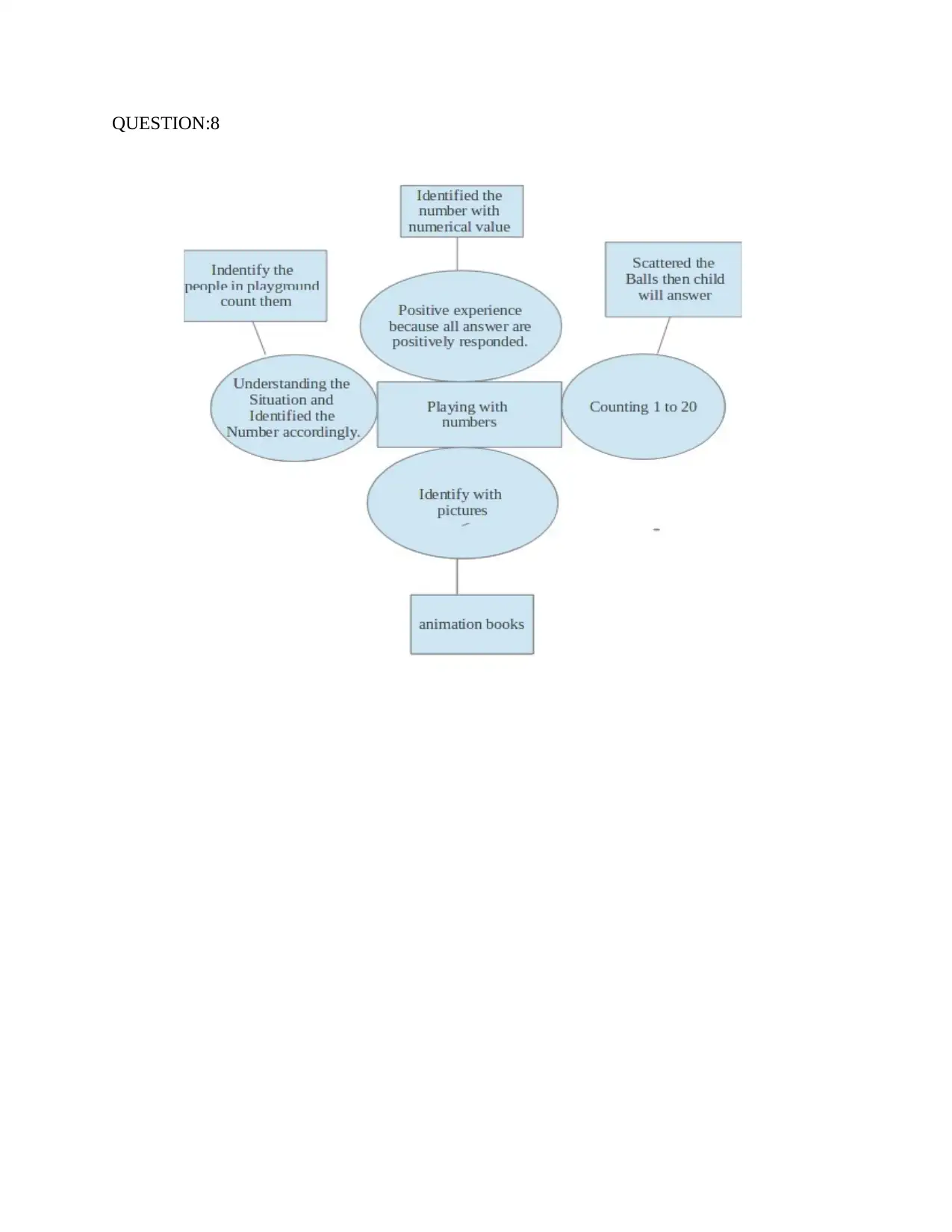
QUESTION:8
⊘ This is a preview!⊘
Do you want full access?
Subscribe today to unlock all pages.

Trusted by 1+ million students worldwide
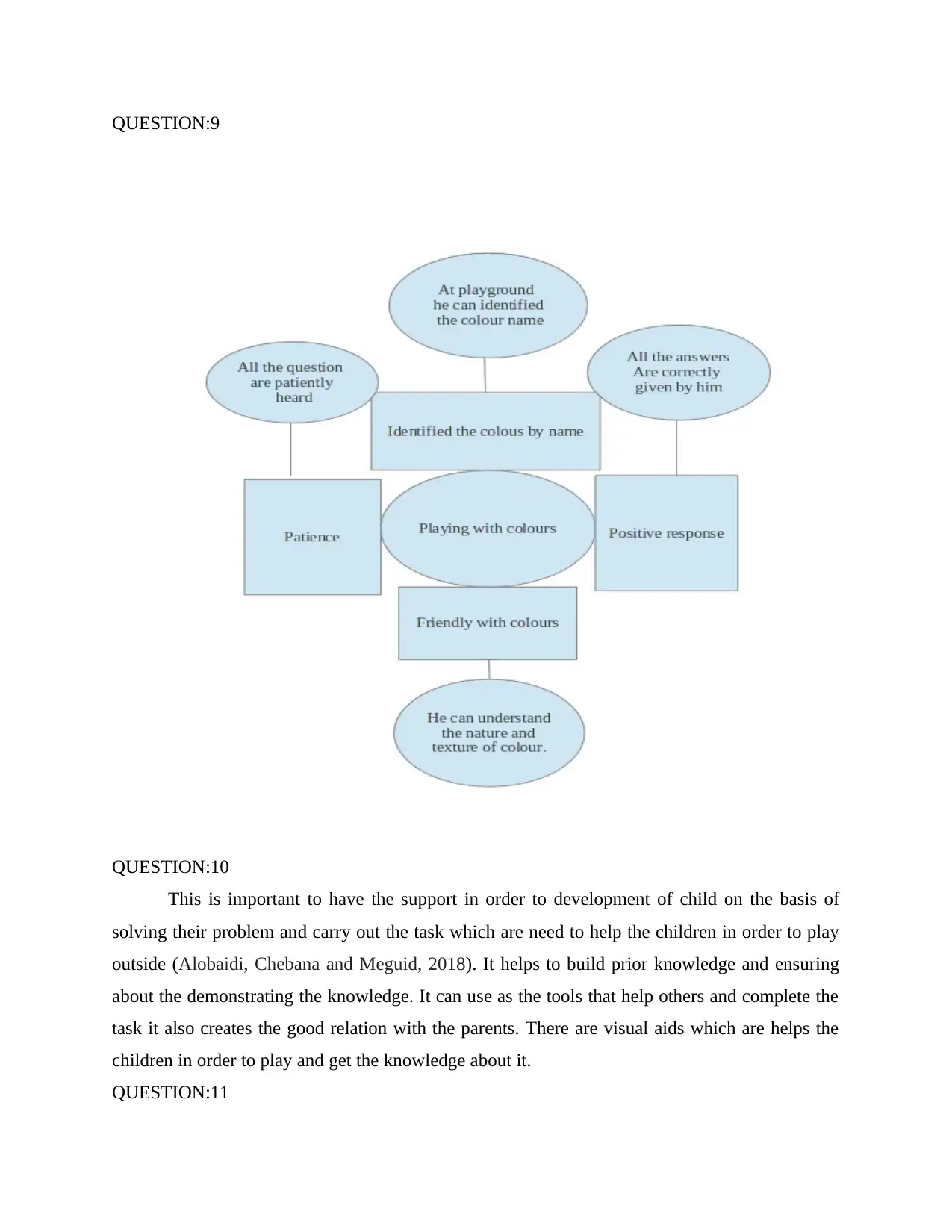
QUESTION:9
QUESTION:10
This is important to have the support in order to development of child on the basis of
solving their problem and carry out the task which are need to help the children in order to play
outside (Alobaidi, Chebana and Meguid, 2018). It helps to build prior knowledge and ensuring
about the demonstrating the knowledge. It can use as the tools that help others and complete the
task it also creates the good relation with the parents. There are visual aids which are helps the
children in order to play and get the knowledge about it.
QUESTION:11
QUESTION:10
This is important to have the support in order to development of child on the basis of
solving their problem and carry out the task which are need to help the children in order to play
outside (Alobaidi, Chebana and Meguid, 2018). It helps to build prior knowledge and ensuring
about the demonstrating the knowledge. It can use as the tools that help others and complete the
task it also creates the good relation with the parents. There are visual aids which are helps the
children in order to play and get the knowledge about it.
QUESTION:11
Paraphrase This Document
Need a fresh take? Get an instant paraphrase of this document with our AI Paraphraser
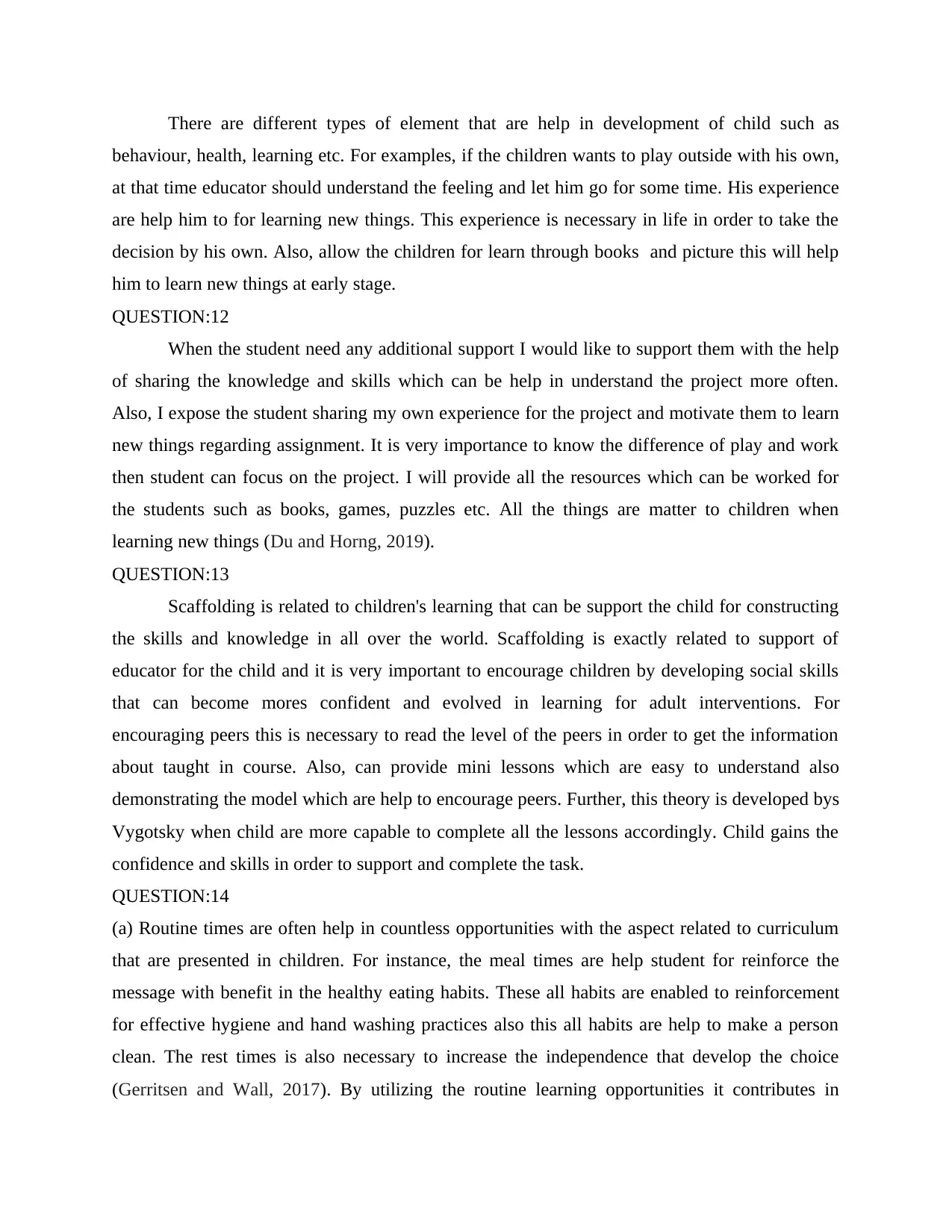
There are different types of element that are help in development of child such as
behaviour, health, learning etc. For examples, if the children wants to play outside with his own,
at that time educator should understand the feeling and let him go for some time. His experience
are help him to for learning new things. This experience is necessary in life in order to take the
decision by his own. Also, allow the children for learn through books and picture this will help
him to learn new things at early stage.
QUESTION:12
When the student need any additional support I would like to support them with the help
of sharing the knowledge and skills which can be help in understand the project more often.
Also, I expose the student sharing my own experience for the project and motivate them to learn
new things regarding assignment. It is very importance to know the difference of play and work
then student can focus on the project. I will provide all the resources which can be worked for
the students such as books, games, puzzles etc. All the things are matter to children when
learning new things (Du and Horng, 2019).
QUESTION:13
Scaffolding is related to children's learning that can be support the child for constructing
the skills and knowledge in all over the world. Scaffolding is exactly related to support of
educator for the child and it is very important to encourage children by developing social skills
that can become mores confident and evolved in learning for adult interventions. For
encouraging peers this is necessary to read the level of the peers in order to get the information
about taught in course. Also, can provide mini lessons which are easy to understand also
demonstrating the model which are help to encourage peers. Further, this theory is developed bys
Vygotsky when child are more capable to complete all the lessons accordingly. Child gains the
confidence and skills in order to support and complete the task.
QUESTION:14
(a) Routine times are often help in countless opportunities with the aspect related to curriculum
that are presented in children. For instance, the meal times are help student for reinforce the
message with benefit in the healthy eating habits. These all habits are enabled to reinforcement
for effective hygiene and hand washing practices also this all habits are help to make a person
clean. The rest times is also necessary to increase the independence that develop the choice
(Gerritsen and Wall, 2017). By utilizing the routine learning opportunities it contributes in
behaviour, health, learning etc. For examples, if the children wants to play outside with his own,
at that time educator should understand the feeling and let him go for some time. His experience
are help him to for learning new things. This experience is necessary in life in order to take the
decision by his own. Also, allow the children for learn through books and picture this will help
him to learn new things at early stage.
QUESTION:12
When the student need any additional support I would like to support them with the help
of sharing the knowledge and skills which can be help in understand the project more often.
Also, I expose the student sharing my own experience for the project and motivate them to learn
new things regarding assignment. It is very importance to know the difference of play and work
then student can focus on the project. I will provide all the resources which can be worked for
the students such as books, games, puzzles etc. All the things are matter to children when
learning new things (Du and Horng, 2019).
QUESTION:13
Scaffolding is related to children's learning that can be support the child for constructing
the skills and knowledge in all over the world. Scaffolding is exactly related to support of
educator for the child and it is very important to encourage children by developing social skills
that can become mores confident and evolved in learning for adult interventions. For
encouraging peers this is necessary to read the level of the peers in order to get the information
about taught in course. Also, can provide mini lessons which are easy to understand also
demonstrating the model which are help to encourage peers. Further, this theory is developed bys
Vygotsky when child are more capable to complete all the lessons accordingly. Child gains the
confidence and skills in order to support and complete the task.
QUESTION:14
(a) Routine times are often help in countless opportunities with the aspect related to curriculum
that are presented in children. For instance, the meal times are help student for reinforce the
message with benefit in the healthy eating habits. These all habits are enabled to reinforcement
for effective hygiene and hand washing practices also this all habits are help to make a person
clean. The rest times is also necessary to increase the independence that develop the choice
(Gerritsen and Wall, 2017). By utilizing the routine learning opportunities it contributes in

various activities related to child growing and it is help in decision-making and gaining the
control during each part of the days. There are so many policies and routine activities which are
often used in procedure. The effective routine transition are related to the families which are help
them to create.
(b) With the help of motivate the children I would like to share related stories so that it can help
for encourage him. Also, encourage him by providing different types of indoor activities which
are help to motivate him in order to learn new things. Also, this type of activities enjoyed by
children and build the new experience for it. Children are more like the outdoor activities so that
they can share their experience with friends and classmates. It start communication with other
students so that it encourage the student.
(c) Outdoor experience is very important for the student in which they can experience more
activities which are need to promote mental health, there are different activities which are
allowed enjoying in sunlight and fresh air (Blossfeld and Triventi, 2017). I would like to
encourage student for playing with others and get interact with others. These activities are help in
collaboration with senior and junior students.
QUESTION:15
Done by supervisor side.
QUESTION:16
Yes, all the information are written in my own words and this is the true indication of my
knowledge and skills. Also, attached the references for the same.
control during each part of the days. There are so many policies and routine activities which are
often used in procedure. The effective routine transition are related to the families which are help
them to create.
(b) With the help of motivate the children I would like to share related stories so that it can help
for encourage him. Also, encourage him by providing different types of indoor activities which
are help to motivate him in order to learn new things. Also, this type of activities enjoyed by
children and build the new experience for it. Children are more like the outdoor activities so that
they can share their experience with friends and classmates. It start communication with other
students so that it encourage the student.
(c) Outdoor experience is very important for the student in which they can experience more
activities which are need to promote mental health, there are different activities which are
allowed enjoying in sunlight and fresh air (Blossfeld and Triventi, 2017). I would like to
encourage student for playing with others and get interact with others. These activities are help in
collaboration with senior and junior students.
QUESTION:15
Done by supervisor side.
QUESTION:16
Yes, all the information are written in my own words and this is the true indication of my
knowledge and skills. Also, attached the references for the same.
⊘ This is a preview!⊘
Do you want full access?
Subscribe today to unlock all pages.

Trusted by 1+ million students worldwide
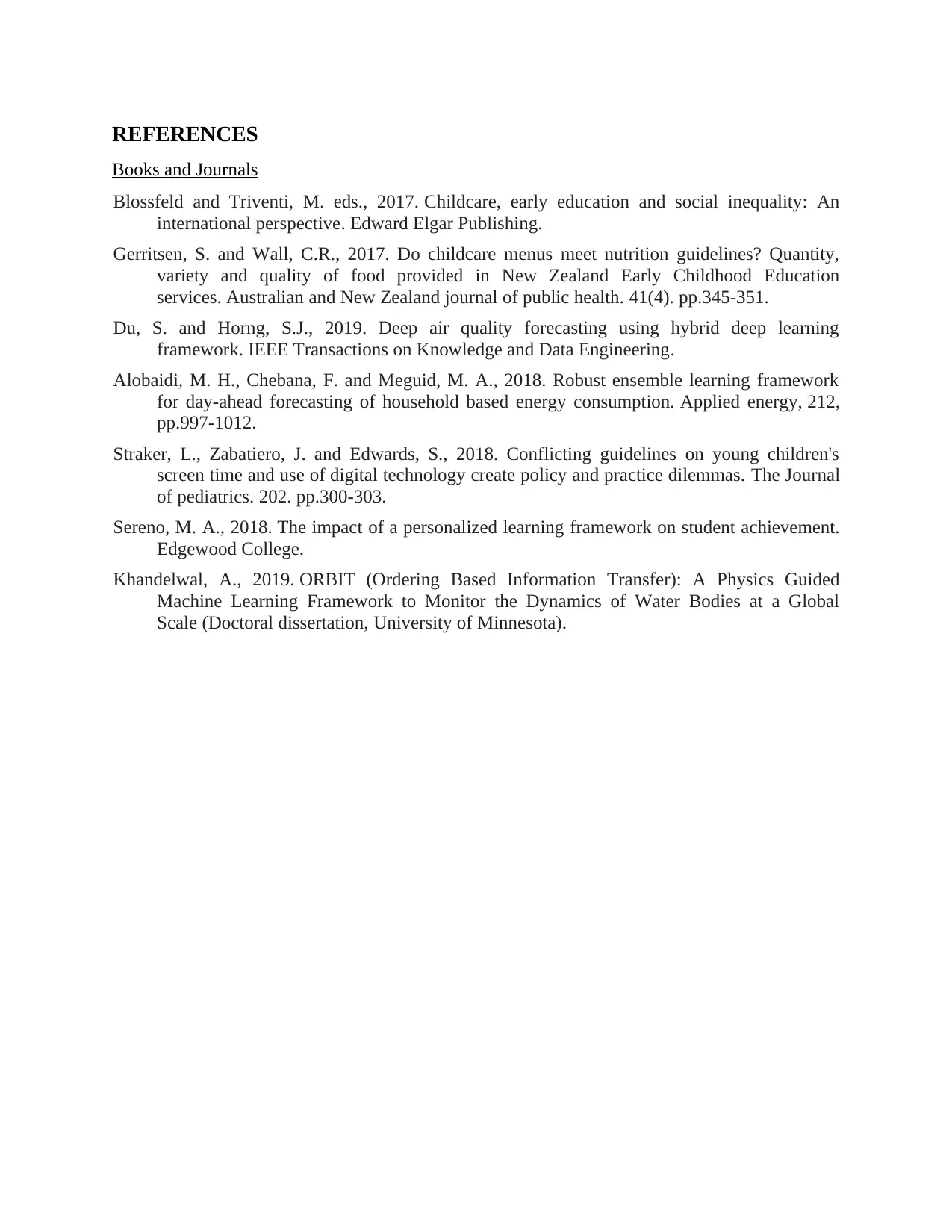
REFERENCES
Books and Journals
Blossfeld and Triventi, M. eds., 2017. Childcare, early education and social inequality: An
international perspective. Edward Elgar Publishing.
Gerritsen, S. and Wall, C.R., 2017. Do childcare menus meet nutrition guidelines? Quantity,
variety and quality of food provided in New Zealand Early Childhood Education
services. Australian and New Zealand journal of public health. 41(4). pp.345-351.
Du, S. and Horng, S.J., 2019. Deep air quality forecasting using hybrid deep learning
framework. IEEE Transactions on Knowledge and Data Engineering.
Alobaidi, M. H., Chebana, F. and Meguid, M. A., 2018. Robust ensemble learning framework
for day-ahead forecasting of household based energy consumption. Applied energy, 212,
pp.997-1012.
Straker, L., Zabatiero, J. and Edwards, S., 2018. Conflicting guidelines on young children's
screen time and use of digital technology create policy and practice dilemmas. The Journal
of pediatrics. 202. pp.300-303.
Sereno, M. A., 2018. The impact of a personalized learning framework on student achievement.
Edgewood College.
Khandelwal, A., 2019. ORBIT (Ordering Based Information Transfer): A Physics Guided
Machine Learning Framework to Monitor the Dynamics of Water Bodies at a Global
Scale (Doctoral dissertation, University of Minnesota).
Books and Journals
Blossfeld and Triventi, M. eds., 2017. Childcare, early education and social inequality: An
international perspective. Edward Elgar Publishing.
Gerritsen, S. and Wall, C.R., 2017. Do childcare menus meet nutrition guidelines? Quantity,
variety and quality of food provided in New Zealand Early Childhood Education
services. Australian and New Zealand journal of public health. 41(4). pp.345-351.
Du, S. and Horng, S.J., 2019. Deep air quality forecasting using hybrid deep learning
framework. IEEE Transactions on Knowledge and Data Engineering.
Alobaidi, M. H., Chebana, F. and Meguid, M. A., 2018. Robust ensemble learning framework
for day-ahead forecasting of household based energy consumption. Applied energy, 212,
pp.997-1012.
Straker, L., Zabatiero, J. and Edwards, S., 2018. Conflicting guidelines on young children's
screen time and use of digital technology create policy and practice dilemmas. The Journal
of pediatrics. 202. pp.300-303.
Sereno, M. A., 2018. The impact of a personalized learning framework on student achievement.
Edgewood College.
Khandelwal, A., 2019. ORBIT (Ordering Based Information Transfer): A Physics Guided
Machine Learning Framework to Monitor the Dynamics of Water Bodies at a Global
Scale (Doctoral dissertation, University of Minnesota).
1 out of 10
Related Documents
Your All-in-One AI-Powered Toolkit for Academic Success.
+13062052269
info@desklib.com
Available 24*7 on WhatsApp / Email
![[object Object]](/_next/static/media/star-bottom.7253800d.svg)
Unlock your academic potential
Copyright © 2020–2025 A2Z Services. All Rights Reserved. Developed and managed by ZUCOL.





